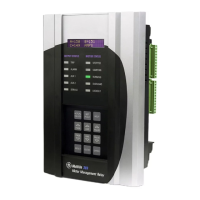
Do you have a question about the GE Multilin 369 and is the answer not in the manual?
| Category | Relays |
|---|---|
| Mounting | Panel Mount |
| Current Rating | 5 A |
| Communication Protocols | Modbus RTU, Modbus TCP/IP, DNP3.0 |
| Protection Functions | Overcurrent, Ground Fault, Overtemperature, Underpower |
| Display | LCD Display |
| Metering | Voltage, Current, Power, Energy, Power Factor |
| Digital Outputs | 4 |
| Digital Inputs | 8 Configurable Digital Inputs |
Provides a high-level summary of the 369 Motor Management Relay's capabilities.
Details the front and rear views of the 369 relay, highlighting key features and ports.
Explains the meaning of each numbered label on the 369 relay's identification plate.
Covers the physical mounting requirements and dimensions for installing the 369 relay.
Lists all terminal connections and their corresponding wiring functions on the 369 relay.
Provides a visual representation of terminal groupings and their physical arrangement on the relay.
Outlines the electrical connections and wiring practices for the 369 relay.
Illustrates common wiring configurations for connecting the 369 relay to a motor system.
Specifies the required voltage ranges and connection procedures for the relay's control power.
Describes how to connect and use a separate display module for the 369 relay.
Details the function, configuration, and operation of the 369 relay's output relays.
Explains the setup and wiring for RS485 serial communication with the 369 relay.
Describes the physical controls and indicators on the 369 relay's front panel.
Details the 40-character LCD display for messages, values, and setpoints.
Explains the function of each LED indicator on the relay's front panel.
Describes the use of the RS232 port for PC connection and software interaction.
Explains how to navigate menus and setpoints using the relay's keypad.
Details the procedure for entering and securing setpoints via the keypad.
Covers the requirements and installation of the GE EnerVista 369 Setup software.
Lists the minimum system requirements for running the EnerVista 369 Setup software.
Provides step-by-step instructions for installing the EnerVista 369 Setup software.
Guides on establishing communication between the setup software and the 369 relay.
Details the process for setting up serial communication parameters for the relay.
Explains the quick connection method using the RS232 front port.
Describes how to configure Ethernet communication settings for the relay.
Explains how to access and modify setpoints using the relay's keypad interface.
Details the security levels and procedures for accessing setpoints via the front panel.
Covers system configuration setpoints, including CT/VT setup.
Provides a practical example of configuring Current Transformer (CT) and Voltage Transformer (VT) settings.
Details the overload protection features and their configuration.
Explains the principles of motor heating and thermal limits.
Describes the standard and custom overload curves used for motor protection.
Explains how to configure the overload alarm for motor protection.
Covers protection functions based on current readings.
Details the configuration of the short circuit protection feature.
Describes power measurement and related protective functions.
Configuration for detecting and responding to lead power factor conditions.
Configuration for detecting and responding to lag power factor conditions.
Configuration for monitoring and protecting against positive reactive power.
Configuration for monitoring and protecting against negative reactive power.
Configuration for detecting and responding to underpower conditions.
Configuration for detecting and responding to reverse power conditions.
Covers configuration of digital inputs for various functions.
Explains the general functions assignable to digital inputs.
Details how to configure a spare digital input as a switch function.
Configuration for an emergency restart input to override protection.
Configuration for a differential switch input for trip functions.
Configuration for a speed switch input for protection.
Configuration for a remote reset input to reset the relay.
Details the configuration of analog outputs for signal transmission.
Explains how to set up analog output parameters like range and scaling.
Covers procedures for testing relay outputs and analog signals.
Describes how to force output relays for testing purposes.
Explains how to force analog outputs for testing and verification.
Provides a summary of the relay's features and capabilities.
Lists all measurable electrical quantities provided by the 369 relay.
Details the various protection elements available in the 369 relay.
Highlights optional features and communication interfaces for the 369 relay.
Provides detailed technical specifications for the 369 relay.
Specifies the technical details for all input types to the 369 relay.
Details the specifications for analog and relay outputs of the 369.
Lists the accuracy, resolution, and range for metered quantities.
Specifies the technical details of communication ports and protocols.
Provides detailed parameters for each protection element.
Details the parameters for monitoring functions like demand and status.
Specifies parameters for control functions like auto-restarts.
Outlines operating and storage conditions for the relay.
Provides guidelines for storing the relay to prevent degradation.
Lists the safety and regulatory approvals obtained by the 369 relay.
References the standards the relay has been tested against.
Details the tests performed during the manufacturing process.
